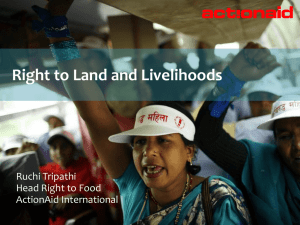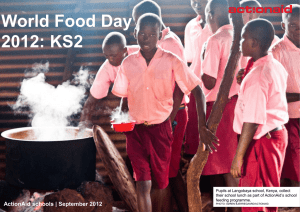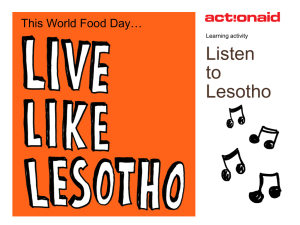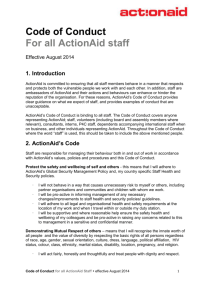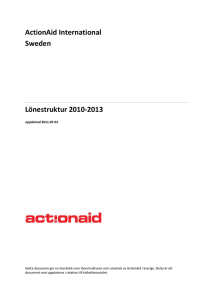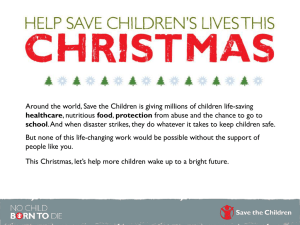World Food Day 2012 - KS3
advertisement
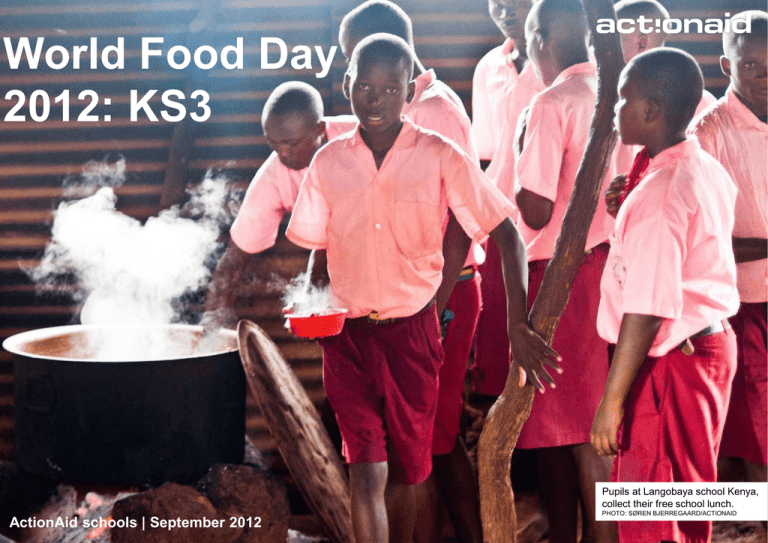
World Food Day 2012: KS3 Pupils at Langobaya school Kenya, collect their free school lunch. ActionAid schools | September 2012 PHOTO: SØREN BJERREGAARD/ACTIONAID ActionAid schools | September 2012 | 1 ActionAid schools | September 2012 | 2 Maize is the most widely grown staple crop in Africa – more than 300 million Africans depend on it as their main food source. Thikhala Chilembwe, 14, from Malawi. PHOTO: CAMERON MCNEE/MISSIONMALAWI//ACTIONAID Margret David harvests a healthy crop from her garden in Malawi. PHOTO: ACTIONAID ActionAid schools | September 2012 | 3 Why has this maize crop dried up? Can you think of three reasons? The Yaa family's failed maize crop in Langobaya, Kenya. PHOTO: DES WILLIE/ACTIONAID ActionAid schools | September 2012 | 4 Mariam Yaa, 10, collects water and tends the Mariam Yaa, 10, at her homestead in family’s goats in Langobaya, Kenya. Kenya. PHOTO: DESLangobaya, WILLIE/ACTIONAID PHOTO: DES WILLIE/ACTIONAID ActionAid schools | September 2012 | 5 The Yaa family’s maize crop has failed due to recurrent drought. As a result, the family have only 5kg of beans and 5kg of rice to eat for the next three weeks. Karisa, Mariam and Karembo Yaa at home in Langobaya, Kenya. PHOTO: DES WILLIE/ACTIONAID ActionAid schools | September 2012 | 6 Consequences wheel No water supply What are the consequences of drought? ActionAid schools | September 2012 | 7 ActionAid schools | September 2012 | 8 Flash floods used to happen here every four to six years. However, due to deforestation and climate change, there have Mukta and her friends in their home villagebeen floods here for eight out of in Sunamganj district, Bangladesh. the last 10 years. TOM PIETRASIK/ACTIONAID Mukta’s mother, Shofikun, plants rice with the community in Char Harikesh, Bangladesh. PHOTO: NICOLAS AXELROD/ACTIONAID ActionAid schools | September 2012 | 9 “I feel afraid. When the floods come, our houses fall – everything collapses. Strong floods suddenly rush down the mountains and we run to the school building to take shelter. We don’t have enough food. You get pains in your stomach if you can’t eat.” Mukta and her mother Shofikun. PHOTO: NICOLAS AXELROD/ACTIONAID ActionAid schools | September 2012 | 10 “Father sowed the fields and mother and I helped with the weeding. After the paddy grew, we dried the crops under the sun and then sold some, but kept half for ourselves. Before, we went hungry and earning money was difficult, but now I like the harvesting season.” Mukta and her mother Shofikun. Mukta in the family's vegetable garden. PHOTO: NICOLAS AXELROD/ACTIONAID PHOTO: NICOLAS AXELROD/ACTIONAID ActionAid schools | September 2012 | 11 ActionAid schools | September 2012 | 12 Reuben Chidimba with a baby goat at home in Rumphi district, Malawi. Reuben plays with his village friends. PHOTO: GRAEME WILLIAMS/PANOS/ACTIONAID PHOTO: GRAEME WILLIAMS/PANOS/ACTIONAID ActionAid schools | September 2012 | 13 Thabu Chidimba, a smallholder farmer, in the fields she shares with other local women. PHOTO: GRAEME WILLIAMS/PANOS/ACTIONAID ActionAid schools | September 2012 | 14 Describe what you see in this picture. Do you think it would be easy or difficult to grow food in this area? Typical landscape in Rumphi district, Malawi. PHOTO: GRAEME WILLIAMS/PANOS/ACTIONAID0 ActionAid schools | September 2012 | 15 What links all these pictures together? Lina Gondwe helps sprouting maize plants to grow. PHOTO: GRAEME WILLIAMS/PANOS/ACTIONAID Contrasting methods of growing maize, Rumphi District, Malawi. PHOTO: GRAEME WILLIAMS/PANOS/ACTIONAID Compost heaps made by women farmers in Rumphi district, Malawi. PHOTO: GRAEME WILLIAMS/PANOS/ACTIONAID ActionAid schools | September 2012 | 16 Thabu and other women farmers on their irrigated land, Rumphi District, Malawi PHOTO: GRAEME WILLIAMS/PANOS/ACTIONAID ActionAid schools | September 2012 | 17 Key question: why do one in six people go hungry? The way we are producing food is unsustainable We need to redesign the whole food system Global food prices are rising due to extreme weather Too much land is being used to grow crops for biofuels Lamb, beef and cheese have the largest food footprint People living in poverty don’t have money to buy food People in developing countries are not growing enough food There are too many people in the world and not enough food We are eating too much meat We are wasting too much food Climate change is causing more extreme weather ActionAid schools | September 2012 | 18 Zone of relevance Why do one in six people go hungry? Most relevant points Relevant points Irrelevant points ActionAid schools | September 2012 | 19 • Investigate one of the questions above. • Present your findings to the class in a creative way. ActionAid schools | September 2012 | 20 Further information sources/ interesting articles Hunger http://www.wfp.org/hunger/faqs The last thing our hungry world needs is more food http://www.dailymail.co.uk/debate/article-1353810/Beddingtons-perfect-stormLast-thing-hungry-world-needs-food.html#ixzz26pnCk2EK Global food prices rise in July due to extreme weather http://www.bbc.co.uk/news/business-19193390 Lamb, beef and cheese have the largest food footprint http://www.theecologist.org/News/news_analysis/986252/lamb_beef_and_chee se_have_largest_food_footprint.html Meat eaters guide to climate and health http://www.ewg.org/meateatersguide/ The food crisis should not be left to cowboy capitalists, Jeremy Grantham, Financial Times August 14 2012, http://www.ft.com The future of food and farming, John Beddington, Chief Scientific adviser http://www.bis.gov.uk/assets/foresight/docs/food-and-farming/11-547-future-offood-and-farming-summary Water, drought and food http://www.unwater.org/worldwaterday/faqs.html ActionAid schools | September 2012 | 21

